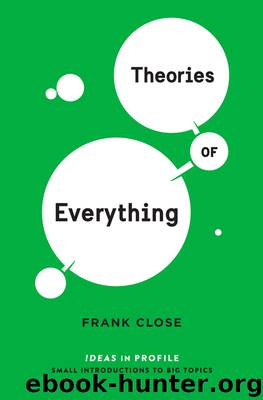Theories of Everything by Frank Close

Author:Frank Close
Language: eng
Format: epub
Publisher: Profile Books
Figure 7: Planck scales: mass, length and time.
The remoteness of the Planck scale is thus both a blessing and a curse. On the one hand, our core theory has no need to include quantum gravity because any deviations that result from its neglect are utterly negligible. The downside, however, is that the domain of quantum gravity is so far away that it is impossible for us to find any clues to guide us towards the correct theory.
GRAVITY BEYOND NEWTON
In 1905, Einstein showed that in a universe without gravity, Newton’s classical mechanics is an approximation to a richer theory, which we know as special relativity. Newton’s theory is an excellent approximation so long as we limit our attention to objects whose speed is small relative to that of light.
Einstein’s theory revealed also that a massive body at rest contains an amount of energy given by E = mc2, where c is the speed of light. When the body is in motion, its total energy is the sum of this rest energy, as it is known, and the energy of its motion, its kinetic energy. So long as the total energy and the rest energy are nearly equal, Newton’s classical theory is an excellent approximation to Einstein’s special relativity theory.
This is the case when the body’s speed is small compared with that of light. In high-energy physics, as its name suggests, this is no longer true. Protons in the LHC, for example, are accelerated so near to light speed that their energy is more than a thousand times larger than their mc2, and Newton’s dynamics is completely inadequate for describing their behaviour. For particles at high energy, Einstein’s special relativity theory holds sway.
The label ‘special’ indicates that this theory of Einstein’s was specialised to the case where gravity is negligible. For the behaviour of individual protons and electrons this is true in practice, and as a result the core theory of particle physics employs special relativity with great success. But what if Einstein had not made this special restriction? How does Newton’s concept of a gravitational field marry with the profound visions of nature that special relativity revealed?
In special relativity, Einstein had not simply demonstrated that Newton’s equations are approximations to some richer mathematics. He had changed our perception of space and time. In Newton’s dynamics, we move through some invisible three-dimensional matrix of space and measure the passage of time by the steady metronome beat of an imaginary clock. This four-dimensional structure (the three familiar dimensions of space, plus time) remains fixed, unchanged, as we pass through it. Einstein’s special relativity, however, implies that our motion subtly alters its fabric.
Someone who moves at a constant high speed relative to you will perceive the spatial grid to contract, and the metronome beat to slow relative to how you, at rest, experience the passage of time. Steady motion, in the sense that we do not speed up or slow down (in essence, that no external forces push or hinder us), alters the fabric of space-time.
Download
This site does not store any files on its server. We only index and link to content provided by other sites. Please contact the content providers to delete copyright contents if any and email us, we'll remove relevant links or contents immediately.
The Elements by Theodore Gray(2994)
Designing Your Life by Bill Burnett(2667)
The Meaning of it All by Richard Feynman(2297)
The Chimp Paradox by Peters Dr Steve(2296)
Why Is God Laughing?: The Path to Joy and Spiritual Optimism by Deepak Chopra(2212)
Tiny Habits by BJ Fogg(1896)
Cosmos by Carl Sagan(1679)
Women in Science by Rachel Ignotofsky(1663)
Predation ID Manual by Kurt Alt(1653)
Vaccine Epidemic by Louise Kuo Habakus(1624)
You're Not Listening by Kate Murphy(1574)
The Courage to Be Happy by Ichiro Kishimi & Fumitake Koga(1361)
The Science of Why by Jay Ingram(1335)
The Science of Superheroes by Mark Brake(1290)
The Dragons of Eden: Speculations on the Evolution of Human Intelligence by Carl Sagan(1213)
The Science of Why 2 by Jay Ingram(1198)
The Double Helix (1968) by 11. James D. Watson(1157)
Dragons of Eden by Carl Sagan(1128)
0345315367 by Carl Sagan(1118)
